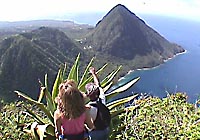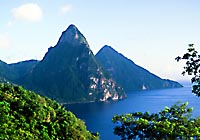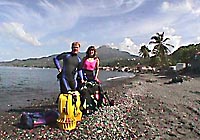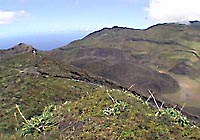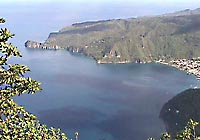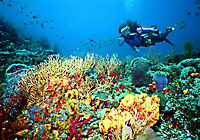| |
 |
|
What We Learned
March 20, 2000
 By Wayne & Karen Brown By Wayne & Karen Brown |
We've come to the end of our expedition. We wish we had more time to explore and learn. Unfortunately we have to leave these beautiful islands and all of our new friends. As we are getting ready to return home we would like to think about what we have learned during our expedition.
St. Lucia:
The volcanoes that formed this island seem to be dormant and slowly becoming extinct. The island, the people and the reefs seem to be in no danger from any volcanic activity now or in the future. During our mountain biking through the old plantation (see our Journal dated 3/16) we learned that the people who built the original plantation buildings used coral from the reef! St. Lucians are now taking an active part in the protection of the coral reefs through the SMMA (see our Journal dated 3/15). Island Status: No danger from volcanic activity. Coral reefs suffered some damage from hurricane Lenny, but recovery should be speedy and may increase coral Diversity on the reef. |
Martinique:
Mont Pelee is said to be extinct and in no danger of an eruption like the one that destroyed the city of St. Pierre in 1902 (see our Journal dated 2/29). The coral reefs here seem to be younger than on St. Lucia, probably due to being choked by ash from the eruption. The ships that sunk due to the 1902 eruption are slowly becoming coral reefs and are providing homes for a large number of fish and other marine creatures. Island status: No danger from volcanic activity. Coral reefs are fewer and more scattered, but the ones we saw seem fairly healthy even though the coral coverage is not as extensive as St. Lucia. |
St. Vincent:
St. Vincent: La Soufriere volcano is being closely monitored for increasing volcanic activity. We saw that a large dome is forming inside the volcano's caldera. We also discovered that the large lake that filled the caldera is now almost completely gone (see our Journal dated 3/3). These changes are signs of continuing and increasing volcanic activity. Island Status: Parts of the island could be in danger from future volcanic eruptions. Large eruptions could damage the coral reefs. Currently, the coral reefs are healthy with lots of coral coverage and diversity. |
| Looking at just the coral reefs, St. Lucia seems to have the best system for protecting their reefs. St. Lucia also has probably the best example of marine life diversity at Anse Chastanet Reef. More varieties of marine life can be found in this one place than any place we have visited on this expedition. Fortunately this is a protected marine reserve and should continue to provide an excellent home for a wide variety of marine life.
All the islands we visited have to be careful with development of their islands. Cutting down the rainforests for growing or building could result in erosion. The sediments that wash off the hillsides, down the rivers and into the sea could seriously damage and kill the coral reefs that are an important natural resource. Fortunately, unlike the former plantation owners, the people of these islands realize that the coral reefs are an important resource that needs their protection. As long as the protection of these reefs are continues you should be able to visit the reefs in the future and experience the beauty and wonder (and gross things, too!) that lie just below the surface. We hope you will have a chance to visit these islands and see for yourself the natural treasures that are here on land and underwater. Thank you for being a part of our expedition. |
|
|
At the top of the Petit Piton, looking south, Meno shows Karen the Gros Piton. See how St. Lucia flattens out south of the Pitons.
The Pitons are the landmarks of St. Lucia and can be seen from Martinique and St. Vincent.
IWayne and Karen on the beach in St. Pierre, Martinique, with their scuba equipment and underwater scooters. Notice Mont Pele in the background with its peak poking out from the clouds.
Can you find Karen and Trevor Bailey standing on the rim of La Soufriere volcano in St. Vincent?
Soufriere Bay is one of the areas where coral reefs are protected by the Soufriere Marine Management Authority.
This area in St. Luica has the greatest variety of corals we've ever seen.
|
|

